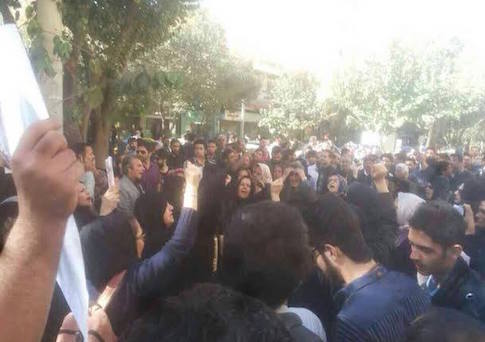More than 1,000 Iranians took to the streets across Iran early Wednesday to protest a rash of so-called "acid attacks" against women who do not strictly follow Islamic law, according to Iranian opposition members and video of the mass demonstrations.
Protests against increased frequency of these acid attacks erupted outside Iran’s Justice Ministry in Isfahan and in other Iranian cities, with anti-regime protestors demanding that the extremist perpetrators of these attacks be brought to justice.
"Death to acid attackers," protestors chanted in Farsi, according to video of the protests in Isfahan. "Guns, tanks, cannot be used to [force use of] the veil, we will sit here until we get an answer. State Security Forces, where are the eyes of our sisters?"
Acid attacks against women have sharply risen in recent weeks in Isfahan and other cities. Men on motorcycles have been driving up to women they deem to be immodestly dressed and dousing them with sulphuric acid, which leaves severe and disfiguring burns on the skin.
At least eight woman have been splashed with acid in recent weeks according to reports by Iranian opposition members, who lashed at Iran’s ruling regime and blamed the government’s extremist policies for promoting this type of crime. Other women have faced similar attacks in Tehran, according to reports.
"The mullahs’ regime that is fearful of mounting popular discontent, especially that of women and the youth, is attempting to prevent the explosion of their wrath through these brutalities and intimidation," Maryam Rajavi, President-elect of the National Council of Resistance of Iran (NCRI), said in a recent statement on the attacks.
The NCRI claims that the attacks are not random and have been coordinated by Iranian regime officials.
The "international community’s silence in the face of these brutalities under the pretext of nuclear talks [with Iran] is tantamount to encouraging the mullahs’ regime to continue these atrocities in Iran," Rajava said.
The protestors demanded immediate justice for the women attacked and pressured Iranian authorities to release the identities of those implicated in the attacks, something the regime has thus far refused to do.
Similar protests took place outside of the Iranian Parliament building in Tehran, according to opposition sources.
One victim identified as 26-year-old Soheila Jorkesh was reportedly attacked by the gangs while sitting in her car with the window open.

Iranian clerics have been blamed for fanning the extremist flame in various sermons condemning women who dress immodestly.
"Confronting mal-veiling and lovers of the West and Western culture is the duty of the State Security Forces," Cleric Alam al-Hoda was quoted as saying in one recent Friday sermon. "The regime’s power and maintaining Sharia and religious codes is the responsibility of security forces and the commander of this force is Khamenei and we should act according to our commander’s orders."
"Mal-veiling" is the term used by Iranian religious authorities to describe when women wear clothing which does not satisfy their standards.
Cleric Movahedi Kermani also expressed similar views in June.
"Emergence of mal-veiled women in the country is a grimace to the system… the authorities should not acquiesce to this… Mal-veiling is not a private sin that nobody should care about … If a sin manifests itself, it then involves everyone and everyone is sinful," Kermani was quoted as saying. "Therefore, necessary provisions should be adopted to eradicate the sin."
Iranian authorities have vowed in recent days to bring the attackers to justice
"One of the unpleasant and criminal acts last week was the acid attacks in Isfahan and the case with this violent action should be pursued by relevant officials and serious and tough action should be adopted for identifying and prosecuting the perpetrators," Iran's Judiciary Spokesman Gholam Hossein Mohseni Ejei said earlier this week, according to the Fars News Agency.
